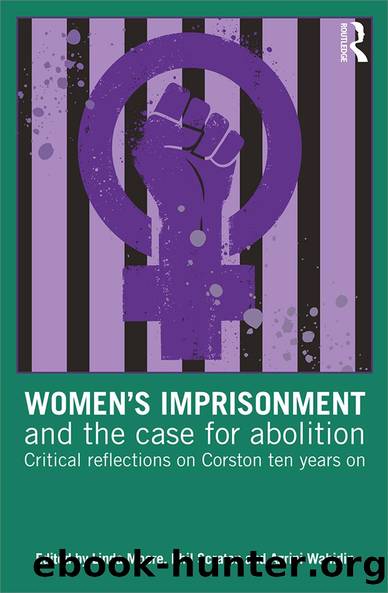Women's Imprisonment and the Case for Abolition by Linda Moore Phil Scraton Azrini Wahidin

Author:Linda Moore, Phil Scraton, Azrini Wahidin [Linda Moore, Phil Scraton, Azrini Wahidin]
Language: eng
Format: epub
Tags: Nonfiction, Social & Cultural Studies, Social Science, Crimes & Criminals, Criminology
ISBN: 9781351792141
Publisher: Taylor and Francis
Published: 2017-11-20T05:00:00+00:00
Conclusion: post-Corston reflections, the failure of reform
Corston (2007: 66) recommended a âdifferent model of provisionâ, supplied by âan integrated approach to servicesâ that would âcut the numbers of women on remand and reduce the risk of re-offending by tackling their criminogenic needsâ. This included âresidential womenâs centresâ to accommodate women remanded for reasons including lack of suitable accommodation or fixed address, âdrug treatment or mental health needs that would not be met in the communityâ and âlow to medium risk offences and awaiting sentenceâ. Corston (2007: 85) envisaged that such centres would support the âtop endâ of non-custodial disposals, anticipating their suitability âfor women either on bail or being released from prison with no suitable accommodationâ. In Northern Ireland, these residential centres never materialised. Whilst the much-acclaimed âInspireâ model of women-centred community provision emerged from a partnership between probation services and the community sector, it did not include the remand population. Rather, it served âwomen who are subject to statutory supervision orders, those whose cases have been adjourned for pre-sentence reports and a small number of women on day release from prisonâ (Kerr 2014: 6). The omission of remanded women from the criteria for referral was counterproductive in reducing offending.
While Corstonâs recommendation for diversion was significant, her vision was restricted by a criminal justice framework underpinning community alternatives. As discussed above, the women interviewed had been remanded to custody, often for reasons beyond the seriousness of their offences. This compounded their social and economic marginalisation while imposing punishment on their lives and families. Despite recognition of the social harms experienced by many vulnerable women, harms that increase their likelihood of facing imprisonment, the focus of reform remained fixed on assumptions regarding womenâs deviance, their troubled environments interpreted as ârisk factorsâ, thus necessitating the continuation of their punishment and control.
At a time of ever-reducing community provision, women categorised as âoffendingâ and requiring punishment will continue to be channelled to prison. It is evidence of the failure of âreformâ. A decade on in Northern Ireland, many of the questions Corstonâs review sought to raise remain unaddressed. Rather than âtransformationâ, womenâs experiences of âgender-specificâ imprisonment reflect mismatched reform alongside an inability to provide appropriate therapeutic settings. In effect, Corston proposed the sanitisation of the punishment administered to women and the initiation of proportionality, which continued to locate women on a carceral continuum where they were considered deserving of punishment. This contrasted with the contextualisation recognised throughout her review. Through the reportâs adoption of a gender-specific lens that is entwined with recommendations of gender âappropriateâ penal environments and measures, Corston effectively binds women to concepts of punishment, confined by the limits of gender-based reform. As this chapter illustrates, these issues are pertinent, particularly for women on remand, each of whom carries the pretrial presumption of innocence and many of whom have not committed an imprisonable offence. Recognition of the structural determination of their marginalisation and criminalisation should promote their removal from the punitive paradigm of criminal justice responses while progressing enhanced public health, social care and welfare provision for the vulnerabilities this population endures.
Download
This site does not store any files on its server. We only index and link to content provided by other sites. Please contact the content providers to delete copyright contents if any and email us, we'll remove relevant links or contents immediately.
Adding Value to Policy Analysis and Advice by Claudia Scott; Karen Baehler(452)
Sociological Perspectives of Health and Illness by Constantinos N. Phellas(444)
Race and American Political Development by unknow(441)
Human and Global Security : An Exploration of Terms by Peter Stoett(423)
American Government and Politics Today by Steffen W. Schmidt Mack C. Shelley Barbara A. Bardes(422)
Control Of Oil - Hardback by Kayal(407)
Entrepreneurship Education and Training: The Issue of Effectiveness by Colette Henry Frances Hill Claire Leitch(358)
The Catholic Church and European State Formation, AD 1000-1500 by Jørgen Møller(354)
Materializing the Middle Passage by Jane Webster;(344)
The World According to China by Elizabeth C. Economy(340)
Left Is Not Woke by Susan Neiman(327)
Theories of Counseling and Psychotherapy: A Case Approach by Nancy L. Murdock(313)
Turkey's Relations with the West and the Turkic Republics: The Rise and Fall of the Turkish Model by Idris Bal(311)
Cross-Cultural Child Development for Social Workers by Lena Robinson(304)
Japan's Ainu Minority in Tokyo by Mark K. Watson(297)
Laboratory Life by Bruno Latour(294)
Advances in Child Development and Behavior, Volume 37 by Patricia J. Bauer(294)
Beyond Service: State Workers, Public Policy, and the Prospects for Democratic Administration by Greg McElligott(284)
The Oxford Handbook of Museum Archaeology by Stevenson Alice;(273)
